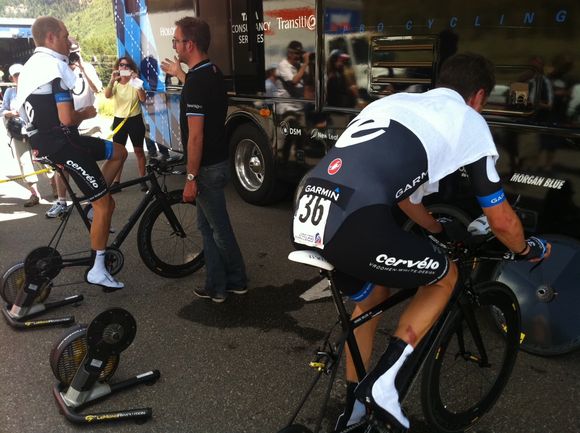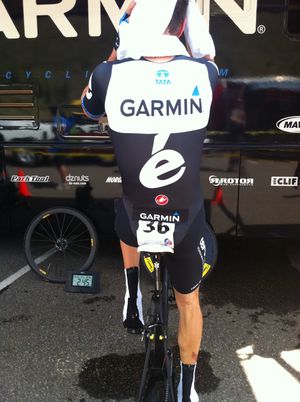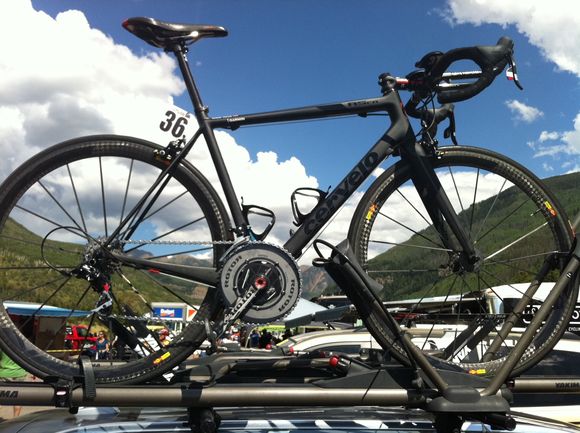
Christian Vande Velde and Tom Danielson (left) warm up as Jonathan Vaughters talks about the course.
They say that cycling is a terrible spectator sport, but that depends on where you’re sitting. On Thursday, thanks to a gracious invitation from Team Garmin-Cervélo, I had the good fortune to watch the USA Pro Cycling Challenge’s from the passenger seat of the trail car that followed Christian Vande Velde up the course. And I’m quite comfortable telling you that there’s nothing—not front row seats at a cage fight, nor even cowboy hat-cam footage of bull riding—more exhilarating than what I witnessed.
The Vail Pass was always going to be one of the best stages to watch: compared to the five-second-long flash and blaze of the passing peloton on a road stage, the TT would treat spectators to an almost three-hour-long stream of racers. It was clear that fans realized this, as cars festooned with carbon bikes choked the highways from Denver to Vail as soon as the sun was up and the bike path from Summit County to the finish on the pass was clogged with picnic-wielding cyclotourists all day. I was among the legion of expectant fans pouring into Vail, though rather than scrabble around in the trenches to stake out a good spot I beelined for the Garmin-Cervélo team bus.
Jonathan Vaughters (JV), ever the iconoclast in his chunky horn rims and slick brown loafers, welcomed me, his poker-dealer cool persona belied by the vaguest hint of anxiety. I asked him how the guys were feeling. “So far so good,” he said. “Tommy D was up sick a little last night, but he’s coming around.” This was a bit of directeur sportif optimistic spin: Tom Danielson, who was the team’s best option at third place on the GC and 22 seconds back, and who is also an ace at uphill TTs, had been up suffering through bouts of vomiting and for the better part of the night and wasn’t even certain he’d take the start. Nonetheless, both he and Vande Velde were warming up on their race bikes in the shade of the team van, headphones blocking out the distracting commotion. Sweat splashed from them both down onto the pavement in spite of the icy towels on their heads and shoulders that a soigneur refreshed constantly. It might sound odd, but just watching these guys ride the trainer was impressive. Vande Velde in particular has an incredibly flat pedal stroke, his body completely still, his shoulders and upper body incomprehensibly tight in the aero bars, every bit of energy directed into the pedals. As a sometimes-racer, it made me realize just how rough and inefficient I am on a bicycle.

There had been talk that I would ride in the car behind Danielson, but because of space constraints I was shifted to Vande Velde’s car, which was fine by me. Though not a TT specialist, Cristian is among the finest all-arounders in the world, and at fifth on GC at only 45 seconds back, if he rode the great ride he was capable of, he could easily move up the leader board. I’d interviewed him before and found him to be down-to-earth and genuine, so it would be a pleasure to trail him and talk with him afterward.
For a cycling enthusiast, a stroll around the team buses at a big race is like a self-guided tour through Santa’s factory for a four-year-old. I’m around high-end bikes constantly for my work, but the glint of so many silky new frames and gleam of carbon disc wheels stacked 15 deep makes even me dizzy. At the Garmin booth, there was lots of discussion of the guy’s gear. While the first half of the course was flat, which favored the totally aero but heavier time trial bike, the second half was a long climb to the finish, for which a road bike was better suited. Garmin’s Dave Zabriskie had ridden the P4, and though he’d been a bit slow on the uphill, three-quarters of the way through the rotation of riders his time was still the fastest on the day. In spite of that, it was decided that as exceptional climbers, both Vande Velde and Danielson would ride the featherweight (but not aero) so as to milk the most from the climb. Vande Velde’s ride was set up with a 53-44 on front, an 11-27 cassette in back, Mavic rear disc wheel and 80mm deep-dish rim in front, and a full 3T aero kit to mimic his position on the P4.

The minutes before his start time were a flurry of activity, with the mechanics doing a final double check, Vande Velde prepping his skin suit and aero helmet, and everyone making sure things were just so. Then Vande Velde rolled down to the start, and JV pedaled a spare bike alongside him for some last-minute encouragement and advice. The mechanic, a team sponsor, and I drove to the start with the spare bike and wheels in the team car, and after JV met us and took over the driver seat, we sped out behind Vande Velde as he whipped out of Vail village and onto the course.
Throughout the flat first half, all talk in the car was whether Christian was faster or slower than Zabriskie. The consensus was slower, though this was put down to the lack of aero bike and the fact that the gusty tailwind had died. Note: that’s ‘slower,’ not ‘slow.’ One thing that was painfully obvious was how hard a gear Vande Velde was pushing and how much constant power he had to produce to go as fast as he was. No coasting, no soft pedaling, just constant, brutal pressure on the pedals. At the midway time check, he was a few seconds off the fastest split, but JV was confident. “This was the plan. It’s the bike,” he said. “He’ll be a lot faster going up.” Just then, race radio crackled through with news that RadioShack’s Levi Leipheimer had come through midway with a new fast time, 18 seconds up on Christian.
The second half of the race was nerve-racking. Over one especially steep kilometer, fans clogged the road, with men in thongs and wrestling masks chasing the riders, a man dressed as a banana jumping up and down with excitement, and , let alone our car. It was thrilling to see so much support for cycling in the US, but also horrifying as we held our breath and prayed that nobody would knock over our rider. “I ran over someone’s foot yesterday,” JV said. “I felt it: bump, bump. With crowds like this, what can you do?” Yet somehow Christian rode like a Zen master, seemingly oblivious to the throngs as he held his aero position and churned. When the road finally opened back up, we all breathed. “That was stressful,” the mechanic said with a sigh.
JV was screaming through the bullhorn. “Go Christian, go! You’re taking back the time. You can win this. Harder! Harder! Harder!” For the entire last kilometer, Vande Velde was out of the saddle sprinting. I thought about the effort it takes to sprint like this uphill for even a short stretch and felt ill watching him. When the finish line finally came, he ramped it up even harder, heaving with the immense effort. And it paid off. His time, 25:47, was not only fastest on the day, but it was good enough for a new course record. After the finish line, JV rolled up and we got our first glimpse at Christian’s face since the start. He looked cross-eyed from the effort, sweat gushed from under his helmet, and when he glanced over at us I had the distinct feeling that not only did he not really recognize us, but he might just vomit in the window of the car. “You can’t imagine how much that hurts,” he would tell me later. “You think about all the things you sacrificed to get there, put your head down, and suffer.”
We were ecstatic and yelling through the car window.��“Amazing ride!” “Great job!!” “Incredible!!!” But��the celebration didn’t last. Race radio hissed again: “Leipheimer finishes with a new best time time of 25:47!” At first we thought there was a mistake. That was the same time as Christian. But then the announcer clarified: Leipheimer had pipped Vande Velde’s time by 58/100ths of a second. Leipheimer was , with Vande Velde slotting into second place at 11 seconds.
In the aftermath, commentary turned to whether equipment choices—Leipheimer rode an aero TT bike; Vande Velde a lightweight climber—had determined the outcome. JV was adamant that the R5ca had been the right choice and that Christian would have been slower on a full TT setup, but arm-chair critics and prognosticators still speculated. In the end, however, no one could argue that, 58/100ths of a second aside, Vande Velde had put in one hell of a ride.
They call the time trail the race of truth because it’s just the rider against the clock. And the TT in Vail was indeed revealing. This was Christian’s second second-place finish in three days (he took second at the USAPCC prologue two days earlier), and no one would have blamed him for being frustrated or finding some excuse (the failing tail wind? the crowds in the way?) for his close call. But he was in good spirits, candid, and self-effacing.��“Who knows, maybe if I had thrown my bike across the line or touched the brakes less in one of the corners I could have made up that half second,”��he told me.��“You could play coulda-shoulda-woulda all day long, but I’m just happy to have ridden well and be on the podium again.”
He might have finished second by a whisker, but with his good humor, lack of excuses, and modest sincerity, Vande Velde proved himself a true champ. And with two stages remaining and only 11 seconds separating him from Leipheimer, the race isn’t over yet.
��